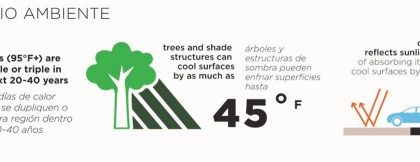
by Beth Flanagan, Marketing Coordinator, Alta Planning + Design
I mean BIG props — like maps that are 40’ x 25’ that people can walk and draw on. Maps that allow people to easily identify their favorite neighborhood destinations, their closest light rail stop, their homes, and the sidewalk and streets they regularly travel. Next, locate the map in a public plaza at the premier transit stop in the study area on a sunny, Saturday afternoon. Add to that happy people milling about enjoying their lunch from the food carts that were brought in for the event and voila! You have the Lakewood, Colorado West Rail Neighborhood Transportation Study Public Meeting.
The Lakewood team (comprised of Alta, Fox-Tuttle, Stantec, and City of Lakewood staff) developed this truly interactive and personal public meeting format for a study aimed at analyzing the traffic impacts for neighborhoods around a newly opened rail line. However, there were so few impacts that the study quickly transformed into improving bicycle and pedestrian connections to the light rail stations in the nearly four-mile corridor. The huge maps allowed people to write or even draw their ideas for improvements or to highlight challenging areas. People easily oriented themselves because their houses were almost 2” square and easy to identify. Over 200 people provided comments and the team estimates that 75% of those comments came from people who did not know about the event, but just happened to be passing by. A group of skateboarders even stopped by to provide their thoughts on what pathways they needed to make their commutes via transit and skateboards more accessible. They were the highlight of the day — and most likely a group who would not have been reached by a traditional evening public meeting.





So how did they do it? The team printed the map of the study area on vinyl at a legible scale and taped it down in the plaza with duct tape. They also created toolkit banners that were hung on 4’ x 8’ frames made of PVC pipe anchored to the ground by concrete blocks. Each banner explained different strategies for traffic calming, bicycle facilities, sidewalks, signage and wayfinding, and street crossings. The banners inspired creativity and gave people the language and concepts they needed to identify solutions for their neighborhood. The team also placed existing conditions analysis maps along the windows of the parking garage that showed bicycle routes, sidewalk gaps, and traffic counts.
It was not a cheap endeavor, however the success paid off in the end. The team was able to work with the city to move around reimbursable costs, consolidate meetings, and reduce costs on other tasks to make this one a real success.
The results? The team ended up with 290 location-specific comments that were analyzed for feasibility of implementation and high demand (via repeat comments). The comments were categorized by location and type (e.g., sidewalk, transit, bicycle facility, traffic calming, signage) and then synthesized into 60 recommendations in the Draft Report. Perhaps the most exciting thing is that nearly 75% can be implemented and funded through the capital improvement budget, and other grants opportunities!
It just goes to show that public involvement DOES matter, and getting people to give their input via nontraditional methods is not only effective, but exciting and fun for everyone!


